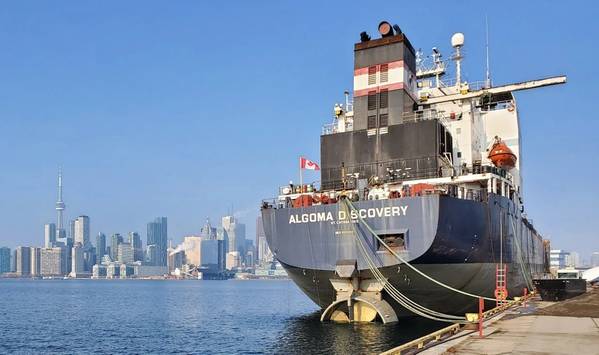
Imports of cement, steel, sugar and salt moving through the Port of Toronto and directly into the heart of Canada's largest city in 2021 surpassed 2.2 million metric tonnes for the 5th consecutive year. Bypassing trade gateways disrupted by the pandemic, Great Lakes – St. Lawrence Seaway shipping routes remained reliable and congestion free, reinforcing the Port of Toronto's important role in the national supply chain. Overall, 190 cargo vessels visited the Port of Toronto in 2021, delivering a range of bulk, project and general cargo products totaling 2,295,815 metric tonnes – a 4% increase from 2020.
The Port had another strong year moving construction materials including steel coils and rebar, cement and aggregate. In 2021, the port recorded cement cargo and steel imports reaching 19 and 18-year highs respectively, with more than 734,000 metric tonnes of cement and 185,000 metric tonnes of steel transiting through the port to construction sites throughout the Greater Toronto Area. Aggregate tonnage more than doubled year-over-year, with 215,232 metric tonnes moving through the port to supply various land erosion projects led by the Toronto and Region Conservation Authority. In addition to importing 572,683 metric tonnes of sugar from Central and South America to support Toronto's food and beverage industry, the port moved 583,425 metric tonnes of salt and saw 4,365 metric tonnes of container services tonnage – a 15% increase over 2020 for container services.
"Shipping has a major role to play in ensuring the sustained resiliency of our national supply chain. In 2021, the Port of Toronto continued to provide a reliable trade gateway for the transportation of goods to the Greater Toronto Area, connecting Toronto to marine ports around the world while much of our transportation sector experienced delays. Further to the economic benefits to the region, shipping is a more efficient way to move goods and produces far less carbon emissions per tonne kilometer than other industries in Canada's transportation system," said Geoffrey Wilson, CEO of PortsToronto. "While the Port of Toronto will continue to play an essential role in our national supply chain in 2022, it will also play an important role supporting Toronto's tourism sector as we anticipate hosting a record 37 cruise ships in 2022, including a number of new cruise ships designed for expedition cruising on the Great Lakes."
Supporting Toronto's tourism and hospitality sectors, the Port of Toronto expects to host a record 37 cruise ships between May and October 2022, including a number of new cruise ships designed for expedition cruising on the Great Lakes. A gateway to Canada's largest city, the Port of Toronto is a turnaround port, allowing Toronto to host arriving and departing cruise ship passengers for several days as they enjoy the many accommodations, restaurants and attractions the city has to offer.
In 2021, the Port of Toronto saw the arrival of three bridge spans from Nova Scotia via tug/barge for Waterfront Toronto's Villiers Island project, and was critical in providing berthing for marine equipment working on the City of Toronto Ashbridge's Bay Sewer Treatment Plant new outfall project.
Through its mixed-use facilities, the Port also plays a role in supporting Toronto's $2 billion film industry by providing a production hub for industry players such as Cinespace and Netflix. This complementary use is facilitated in parallel with traditional port and cruise ship terminal operations, and has proven to be successful in ensuring the full utilization of PortsToronto property.
In addition to its economic impact, increased imports through the Port of Toronto has a positive impact on the environment given the 2.2 million metric tonnes of cargo delivered by ship last year took approximately 57,000, 40-tonne trucks off Toronto's congested roads and highways.


